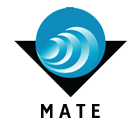
"What a magnificent book. Beautifully presented, laid out and written. Consider it a masterwork for the diving community."
Clive Cussler
Adventure novelist and marine archaeologist
WHEN AND WHERE CAN WE GET IT?
ISBN 978-0-9841737-0-9
- Retail cost: $99.95 per book with a discount for schools (Wholesalers please contact the MATE Center directly at info@marinetech.org.) Shipping is extra.
- No preview copies are available, but sample chapter pages are posted on this website.
Underwater Robotics: Science, Design & Fabrication
Dr. Steven W. Moore, Harry Bohm, and
Vickie Jensen
Click here to see what's inside
Order Form
Chapters 1-3 provide an introduction to underwater vehicles (past and present day), the physical challenges of working under water and the considerations for designing and building underwater vehicles (particularly ROVs).
Chapters 4-11 are the "technical chapters" which provide an in-depth look at various subsystems in underwater vehicles.
Chapter 12 provides hands-on learning. It includes plans for a shallow-diving ROV and a discussion of more complex underwater vehicles.
This book introduces students, educators and other aspiring inventors to subsea technology. This exciting resource provides the information needed to design and build underwater vehicles. It also encourages bright young minds to consider a career in the world of underwater robotics.
This textbook is written for advanced high school classes or college and university entry-level courses. Each chapter begins with a true scenario that sets the stage for the ocean science, physics, math, electronics, and engineering concepts that follow. The final chapter features step-by-step plans for building SeaMATE, a basic shallow-diving ROV. There is also a "What's Next?" section that's full of ideas for modifications and more complex underwater projects.
The 850-page informative text is enhanced by hundreds of photos, illustrations, and diagrams of underwater vehicles. In addition, the textbook includes a discussion of subsea vehicle development, resource appendices, an extensive glossary, and a complex index.
Textual Aids and Information
All chapters include an outline, learning outcomes, and summary. Each chapter is introduced by a real-life scenario (called Stories From Real Life) that relates the basic theoretical information of that chapter to an actual subsea event.
There are over 500 photographs and illustrations throughout this book. The wealth of color photographs helps readers connect with actual examples of subsea robotics. The straight-forward illustrations are designed to expand and explain textual concepts.
- Measurements are given in metric units, generally with imperial equivalents.
- The emboldened terms in the text are defined in the glossary.
- An index helps locate terms.
- The appendices provide helpful tables of information, useful facts, equations, and suggestions for finding materials and resources.


